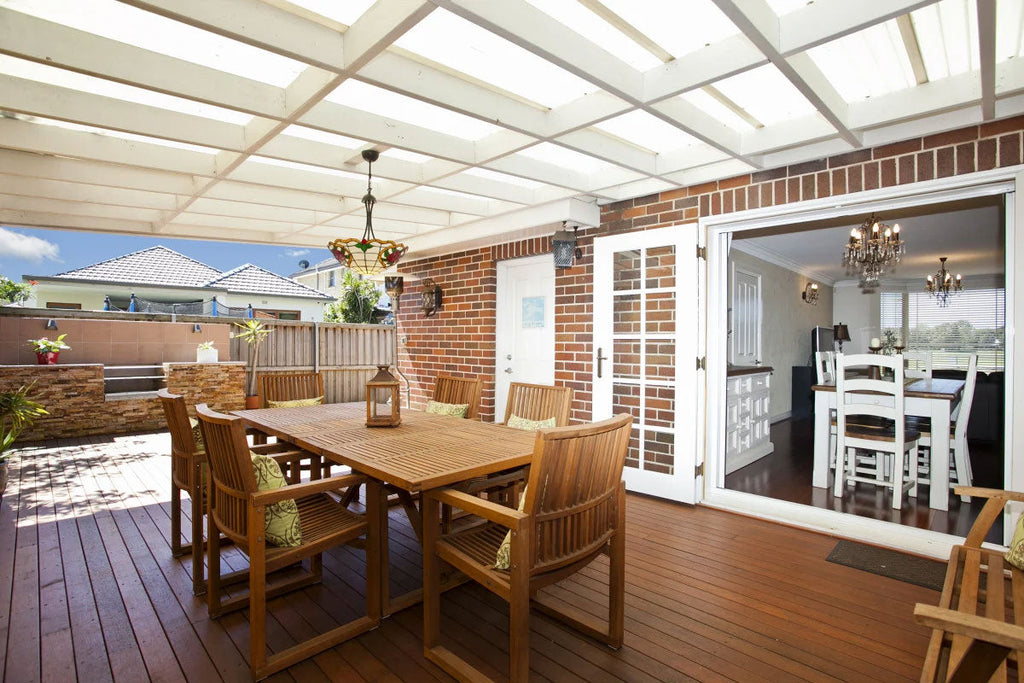Why is My Wood Turning Green? How to Remove Algae From a Wood Deck
Posted by WOCA WOODCARE

Now that it’s officially patio season, it might be time to take your spring cleaning one step further: deep cleaning. Why? Over the winter and spring months, many unsightly things can happen in your treasured outdoor space. Worse than typical leaves, dirt, and mud — and harder to get rid of — is green algae.
What is algae, exactly? Why does it grow on exterior wood surfaces? We’re breaking down what you need to know about algae and how you can safely remove it just in time for summer.
What is algae?
You’ve probably seen it before: a green, slimy film that somehow finds its way onto virtually any exterior surface — your wood deck, wooden garden furniture, and even your siding. That’s green algae, and like moss and mold, it can damage wood.
Biologically speaking, algae is not a single thing. It’s a group of aquatic organisms that produce oxygen through photosynthesis. Although algae don’t have roots, leaves, or stems, they function similarly to plants. Despite producing oxygen and providing tons of other benefits for the environment, algae can harm any home exterior surface it grows on.


How does algae grow on exterior wood?
Algae thrive in dark and moist conditions, which is why you’re likely to see them appear after wetter seasons like winter and spring. Wood surfaces are particularly susceptible because they soak in moisture, becoming the perfect home for algae to settle in.
Algae doesn’t just grow on wood; it can appear on siding, patio furniture, windows, stone, and more. The reason algae is especially harmful to wood is that the moisture can seep deep into the wood, causing it to warp and splinter. Plus, the slimy texture creates slippery surfaces, increasing the chances of falls.
How do you remove algae from wood?
Thankfully, algae doesn’t have to be a persistent headache or damaging to your exterior wood surfaces. In fact, with the right products and a deep cleaning process, you can remove it without the extra time and effort it often involves. We’ll call that a win.
For your first ‘deep’ clean of the season, WOCA Exterior Wood Cleaner is an incredibly effective and safe cleaning solution for all your exterior surfaces — not just wood. It can be used on:
- Wooden decks
- Patio furniture
- Brick
- Stone pavers
- Siding
- Outdoor tile
- Concrete
It not only removes algae (and other harmful growth like mold, moss, and stains) but also protects your surfaces from regrowth.
Here's a step-by-step guide to removing algae:
- Soak the surface with a garden hose.
-
Dilute WOCA Exterior Cleaner with 1 part solution to 2 parts water.
- Apply the solution to the affected areas with a scrub brush or spray, then scrub lengthwise with the wood grain until it appears clean.
- Repeat if necessary.
- Rinse the surface with water immediately after cleaning.
- Leave the surface to dry completely (24 hours) before applying any protective treatment, such as WOCA Exterior Wood Oil.
Pro tip: If your surfaces need regular cleaning throughout the summer, our Exterior Cleaner is safe to use around plants (when diluted)!
Pro tip #2: If your wooden patio or furniture needs an extra deep clean, you can also check out WOCA Exterior Wood Deep Cleaner, which is best for getting rid of oil and dirt on wood surfaces only.
Preventing Future Algae Growth
The best way to prevent algae growth is with regular maintenance. Consider the following prevention tips:
- Seal and Protect: After cleaning your wood surfaces, apply WOCA Exterior Wood Oil to create a protective barrier against moisture and algae growth.
- Proper Drainage: Make sure water doesn’t pool on your patio or deck. Use drainage solutions to keep water from sitting on your wood surfaces.
- Routine Cleaning: Bi-weekly cleaning with WOCA Exterior Wood Cleaner helps prevent regrowth. Scrub the surfaces regularly to keep them fresh and green-free.
- Trim Overhanging Trees: Overhanging trees can keep the wood surfaces shaded and damp, creating the perfect conditions for algae. Trim them back to ensure more sunlight and airflow around your patio.
By staying on top of cleaning and protection, you can keep the green stuff at bay and ensure your wood surfaces look great year-round.
Before and After Photos: See the Difference!
To really appreciate the power of the Exterior Wood Cleaner, check out these before-and-after photos of decks and patios cleaned with our product. The results speak for themselves—a spotless, algae-free surface ready for summer relaxation!

Ready to Clean and Protect Your Outdoor Wood?
Getting your patio summer-ready doesn’t have to require the effort of a deep clean, but you can still get the results of one. With WOCA’s safe and environmentally friendly products, you can keep your outdoor living space and exterior wood surfaces algae-free year-round. Don’t wait for algae to take over your wood surfaces–explore our outdoor collection now so you can have more time to relax later!
SHARE:

